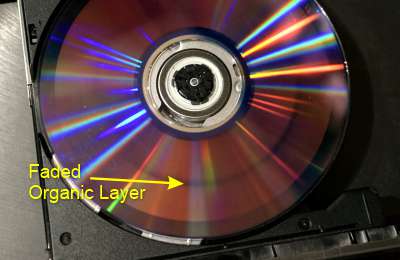The Problem with Optical Media (CD & DVD)
Even though “digital transfer” sounds new, the concept has been around for a long time now. Writable discs became available in the year 2000, so the nascent digital transfer business grew up around that format, copying VHS and home movies to DVD for thousands of clients. And about that same time people started making their own CDs with the then-new CD burner in their computer.
That was over 20 years ago!
But there’s a time bomb ticking inside every writable disc in your closet. Here’s the problem:
DVDs and CDs are a sandwich. Between two layers of plastic, there’s a substrate that contains the data. In pre-recorded “manufactured” (Hollywood movie) discs you would buy at the store, that substrate is aluminum, with physical indentations (aka "pits") that comprise the digital data. Manufactured discs can last 100 years of more, but not so "writable" discs. In DVD-R, DVD+R, DVD-RW, DVD+RW, and writeable CD and BluRay, the middle of the sandwich is an organic dye layer. To write content to a disc on your computer or a DVD recorder, a powerful laser zaps the organic dye, leaving a dark spot, not a pit, to record the data. That’s why a writable disc drive is called a “burner.”
 As with all things organic, however, this layer is not permanent. The layer can fade, grow fungus, or develop blank patches, depending on the quality of manufacture. Sure, some disks will last a long time, but others, even from good brands, have been known to develop problems after a very short time. (Illustration shows dark stripe where the disc faded, producing a glitch in playback.)
As with all things organic, however, this layer is not permanent. The layer can fade, grow fungus, or develop blank patches, depending on the quality of manufacture. Sure, some disks will last a long time, but others, even from good brands, have been known to develop problems after a very short time. (Illustration shows dark stripe where the disc faded, producing a glitch in playback.)
Net result, manufacturers say common writable discs are only good for about 10 years. (Premium "archival" discs may last longer.)
And then there’s the risks involved in disc storage and handling. Scratches, especially those made by faulty DVD/CD players, can render a disc unreadable. And if someone sits on one and cracks it, game over. (Never place a cracked disc in a player. It will fly apart, destroying the player!)
If you had digital transfers made 10 years or so ago on optical media, you’re going to want to preserve that investment – ESPECIALLY if you threw away the source tapes or films.
DIY Data Disc Backup (CD or DVD)
If you have an old data CD or DVD with just files on it, copying those is easy. Just load the disc into your computer's optical drive, view the contents, and copy them to your hard disk or portable backup drive. Then you can burn them to another disc if you prefer to keep your data backup on disc. (Note that if you copy files from optical media to a hard drive, they will retain their "read only" attribute. You may have to change that attribute before working with the files.
Set-top playable CD audio discs and DVD video discs work differently:
Video DVD and Audio CD Backup
If you have a set-top compatible video DVD or audio DVD, you must back up the entire folder structure of the disc to backup media, then burn the same structure to a blank disc. You won't necessarily be able to play the files from a computer or flash drive unless they're properly extracted and transcoded to a modern media format. Commercial recordings may have copy protection schemes that prevent replication.
Bring your discs to Advent Digitizing.
We have the technology to safely extract the contents* and either burn new, fresh DVDs, or transcode and deliver your content on flash drive, where you can then back it all up to your computer and share it with your family or friends.
Don't wait. Your DVD clocks are ticking.
Start Here to preserve your DVDs
*Not a data recovery service. Discs must be playable.